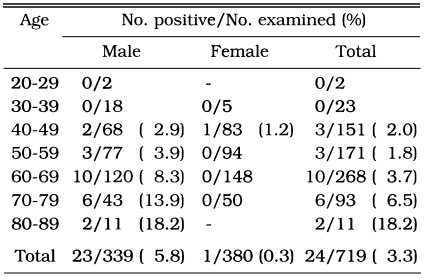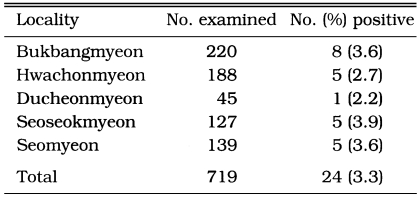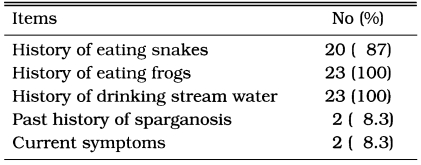Abstract
Gangweon-do is known to be highly endemic area of sparganosis more than other provinces in Korea. A seroepidmiologic examination for the detection of anti-Spirometra erinacei plerocercoid IgG in serum was carried out in normal inhabitants in Hongcheon-gun, Gangweon-do. Sere were tested by enzyme-linked immunosrobent assay (ELISA) for the anti-sparganum antibodies. Positive rate for anti-sparganum antibody in 719 adults was 3.3%. Data of the questionnaire for 24 ELISA positive inhabitants revealed that 20 had a history of eating raw meat of snakes, 24 had a history of eating frogs, and 24 had a history of drinking stream water. Two positive cases had a past history of sparganosis. Two positive cases showed current symptoms of sparganosis. The data revealed that ELISA would be useful to find infected cases among normal inhabitants at sparganosis-endemic areas.
Keywords: sparganosis, seroepidemiology
INTRODUCTION
Human sparganosis is caused by a larval stage of pseudophyllidean tapeworms belonging to the genus Spirometra. Although cases have been reported worldwide, sparganosis is common in Asia (William & Richard, 1985). Its first intermediate host is the copepod, and the second intermediate host included a wide spectrum of vertebrates such as amphibians, reptiles, birds and mammals. Humans are also the second intermediate hosts and would be infected through eating the first or the second intermediate hosts.
Spargana can migrate widely in the human visceral organs and the resulting symptoms are different depending on the particular tissues or organs involved (Thomas & Lawrence, 1995). It's migration to subcutaneous locations is painless and may stay unnoticed (Paul et al., 1984; Burton & Thomas, 2000). Frequently, spargana are discovered accidentally during unrelated surgical procedures. Cerebral sparganosis has been reported with increasing frequency in humans, and is often characterized by convulsions.
It is difficult to diagnose sparganosis, because it does not lay eggs. Usually, diagnosis is not made until surgical removal of the worms from drainage of the lesion and examination of the tissues involved.
Enzyme linked immuno sorbent assay (ELISA) is a sensitive and specific serodiagnostic tool for subcutaneous or cerebral sparganosis (Cho et al., 1990; Morakote & Kong, 1993), therefore it is almost possible to determine whether a patient is infected or not. It is imperative to examine inhabitants at the infection prevalent area before the worm migrates to the brain. In Gangweon-do, the positive rate of sparganum antibody was higher than other provinces in Korea (Kong et al., 1994; Park et al., 2001). This study was carried out to investigate whether ELISA was effective for detection of human sparganosis in normal adults in Gangweon-do, Korea.
MATERIALS AND METHODS
Crude saline extract of spargana
Spargana were collected from naturally infected snakes (Rhabdophis tigrina) caught at Jiri-san, Gyeongsangnam-do. The worms were collected from muscles of snakes, host tissue on the worms was removed, and the worms were washed 3 times with cold saline. The worms were homogenized in 0.01 M Tris-HCl buffer (pH 7.2) at 4℃ for 30 min. The emulsion was shaken for 2 hr and kept for 24 hr at 4℃. After centrifugation at 4℃ by 10,000 g for 30 minutes, the supernatant was taken as crude saline extract. Protein content was 5.0 mg/ml, measured by the method of Lowry method.
ELISA
A total of 719 sere were obtained for biochemical as well as serologic tests from Hongcheon inhabitants who visited Chuncheon-shi branch of the Korea Association of Health Promotion. The sere were processed for routine physical check-ups in 1999. The sera had been stored at -70℃ until used. Serum levels of antibody specific to spargana were measure by ELISA (Kim et al., 1984). The sera of the positive control group were collected from the sparganosis patients confirmed by detection of the worm in Weonju Chiristian Hospital. The crude extract was diluted in carbonate buffer (pH 9.6) at 2.5 µg/ml protein concentration and coated in wells of polystrene microtiter plates (Costar, Cambridge, MA) at 4℃ overnight. After washing, 1:100 diluted sera in phosphate buffered saline/0.05% Tween 20 (PBS/T, pH 7.4) were reacted for 2 hr at 37℃. After washing, 1:1,000 diluted peroxidase-conjugated anti-human IgG (light- and heavy-chain specific, Cappel, West Chester, PA) in PBS/T was reacted for 2 hr at 37℃. After washing, it was reacted at 37℃ for 24 min with the substrate, consisting of 1 ml of 1% orthophenylenediamine, 10 µl of 30% H2O2 and 99 ml of distilled water. Absorbance at 490 nm was read using an ELISA Reader (Dynatech MR300).
Epidemiologic survey
All the ELISA positive cases were investigated individually for the following epidemiologic items by direct or telephone interview: residence, occupation, past history of sparganosis, family history, drinking history of stream water, and especial experience of eating the second intermediate host of sparganum. In the case of direct visiting, environmental situations such as location of stream and the second intermediate host of sparganum in the mountain were also examined.
RESULTS
Antibody positive rates among normal inhabitants
Out of 719 serum samples tested, 24 sera (3.3%) showed positive levels of the anti-sparganum antibody. Of the 339 male inhabitants, 23 showed positive, while 1 of 380 females showed positive. The positive rates in the fourth, fifth, sixth, seventh, and eighth decades of the age were 2.0, 1.8, 3.7, 6.5 and 18.2, respectively (Table 1). There was no positive individuals whose age was under 40. By administrative districts, Sosokmyon showed high rate of positive (3.9%), and other 4 areas (Hwachonmyon, Duchonmyon, Somyon, Bukbangmyon) showed similar rates, ranging from 2.2% to 3.6% (Table 2).
Table 1.
Positive rate of anti-sparganum IgG antibodies in 719 inhabitants, grouped by age and sex
Table 2.
Positive rate of anti-sparganum IgG antibodies in sera obtained from normal inhabitants in Hongcheon-gun, Gangweon-do, Korea
Epidemiologic results
Data of the questionnaire in 24 ELISA positive inhabitants revealed that 20 had a history of eating raw snake meat, 24 had a history of eating frogs, and 24 had a history of drinking stream water. Two positive cases had a past history of sparganosis. Two positive cases currently had symptoms of sparganosis (Table 3).
Table 3.
Epidemiologic survey of the 24 seropositive inhabitants by questionnaires
DISCUSSION
Sparganosis is one of the important larval cestode infections in man, and occurs by ingestion of infected Cyclops spp. or ingestion of raw infected flesh of the second intermediate hosts. In addition local application of raw infected flesh of the second intermediate hosts to the skin may introduce sparganum in humans (Paul et al., 1984; Lynne & David, 1993; Burton & Thomas, 2000).
Sparganosis in Korea might be caused by eating raw snakes and frogs, and drinking stream water containing infected cyclops similar to the cases in other countries (Lee & Ahn, 1996). In this study, most of the positive inhabitants had the history of eating raw snakes and frogs. Furthermore, all of them had the history of drinking stream water around their houses. The positive twenty one inhabitants revealed no present or past symptoms for cutaneous mass, focal neurological manifestations, and other symptoms associated with spaganum. Nevertheless, the possibility of sparganosis could not be excluded, since there have been several reports of asymptomatic cases. It is not certain whether these positive cases may develop any sparganosis symptoms in the future.
Like the sero-positive inhabitants, most of the people living in rural areas in Gangweon-do have had the experience of eating frogs and drinking stream water. Gangweon-do is a mountainous area where there are many streams around the field. A history of eating snake is the most likely infection source of sparganosis in the case of man. In the cases of woman and children, on the contrary, drinking stream water in the field is the main source infection of sparganosis. It is extremely unusual in Korea to eat raw frog meat and locally apply it for the symptom relief.
In this study, the possible cross reactions with other parasites remains still unsolved, since of the antibody crossreacts with cysticercosis and paragonimiasis (Yong et al., 1993; Nishiyama 1994).
We hope that the sparganum-positive cases visit hospitals to treat the worm when they realize the sparganum symptoms such as palpable nodule before the dangerous migration of the worm occurs. ELISA for normal inhabitants during routine physical check-ups may be a useful diagnostic tool to find the hidden sparganosis.
References
- 1.Burton JB, Thomas CC. Human parasitology. 2nd ed. New work: Academic press; 2000. pp. 292–294. [Google Scholar]
- 2.Cho SY, Kang SY, Kong Y. Purification of antigenic protein of sparganum by immunoaffinity chromatography using a monoclonal antibody. Korean J Parasitol. 1990;28:135–142. doi: 10.3347/kjp.1990.28.3.135. [DOI] [PubMed] [Google Scholar]
- 3.Kim H, Kim SI, Cho SY. Serological diagnosis of human sparganosis by means of micro-ELISA. Korean J Parasitol. 1984;22:222–228. doi: 10.3347/kjp.1984.22.2.222. [DOI] [PubMed] [Google Scholar]
- 4.Kong Y, Cho SY, Kang WS. Sparganum infections in normal adult population and epileptic patients in Korea: A seroepidemiologic observation. Korean J Parasitol. 1994;32:85–92. doi: 10.3347/kjp.1994.32.2.85. [DOI] [PubMed] [Google Scholar]
- 5.Lee KJ, Ahn YK. The status of sparganosis in the western areas of Kangwon-do, and experimental indentification of the adult worm. J Wonju College of Med. 1996;9:139–148. [Google Scholar]
- 6.Lynne SG, David AB. Diagnostic medical parasitology. 2nd ed. 1993. pp. 298–300. [Google Scholar]
- 7.Morakote N, Kong Y. Antigenic specificity of 36 and 31 kDa proteins of Spirometra erinacei plerocercoid in tissue invading nematodiasis. Korean J Parasitol. 1993;31:169–171. doi: 10.3347/kjp.1993.31.2.169. [DOI] [PubMed] [Google Scholar]
- 8.Nishiyama T, Ide T, Himes SR, Jr., Ishizaka S, Araki T. Immunodiagnosis of human sparganosis mansoni by micro-chemiluminescence enzyme-linked immunosorbent assay. Trans R Soc Trop Med Hyg. 1994;88:663–665. doi: 10.1016/0035-9203(94)90218-6. [DOI] [PubMed] [Google Scholar]
- 9.Park HY, Lee SU, Kim SH, et al. Epidemiological significance of sero-positive inhabitants against sparganum in Kangwon-do, Korea. Yonsei Med J. 2001;42:371–374. doi: 10.3349/ymj.2001.42.4.371. [DOI] [PubMed] [Google Scholar]
- 10.Paul CB, Rooney CJ, Eddie WC. Clinical parasitology. 9th ed. Philadelphia: Lea & Febiger; 1984. pp. 499–502. [Google Scholar]
- 11.Thomas CO, Lawrence RA. Parasites in human tissues. 10th ed. USA: ASCP press; 1995. pp. 300–301. [Google Scholar]
- 12.William CM, Richard SD. Parasitology. 8th ed. USA: Macmillan Co; 1985. pp. 293–294. [Google Scholar]
- 13.Yong TS, Seo JH, Yeo IS. Serodiagnosis of human paragonimiasis by ELISA-inhibition test using monoclonal antibodies. Korean J Parasitol. 1993;31:141–147. doi: 10.3347/kjp.1993.31.2.141. [DOI] [PubMed] [Google Scholar]





